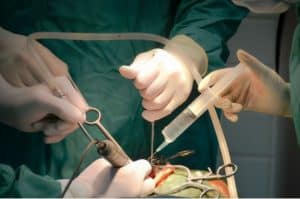Comparing Delivery Methods of Surgical Wound Irrigation
What is the role of surgical wound irrigation in SSI Prevention?

Despite best practices and care, surgical site infection is a significant risk of surgery. Surgical wound irrigation is often used as an effective strategy to prevent and eliminate surgical site contamination by reducing the microbial burden, removing tissue debris, metabolic waste and tissue exudate before site closure. Surgical Irrigation overall has three major variables, delivery method, volume, and solution additives, which can differ significantly.
Thorough irrigation decreases the incidence of surgical wound infection, with a direct proportion or the volume of irrigant used. Types of irrigant solutions include normal saline, or a solution having additives such as antiseptic or antibiotic agents. When choosing a surgical irrigation solution, it is important to choose a solution that is effective against a broad spectrum of gram-positive and gram-negative bacteria, as well as safe and non-cytotoxic for both patient tissue and any implants.
What are common delivery techniques?

The most commonly utilized delivery techniques in surgical wound irrigation are gravity and pulse irrigation. These techniques differ in that gravity irrigation is a continuous flow of irrigation fluid to the tissues at a low continuous pressure (1-2 psi), that is, letting the fluid flow freely by gravity. Gravity flow, as a low-pressure irrigation, may be delivered to the surgical site through tubing, bulb syringe or pitcher.
Pulsed irrigation is another delivery method. It uses a powered device, which provides pulsation of the fluid with forces greater than gravity flow, typically with variable settings such as a low psi pressure settings 5-10 psi to high pressures of >20 psi. Pulsed irrigation, especially at higher-pressures, has demonstrated timely and effective removal of debris and bacteria from tissues. However, it has also been associated with a greater degree of tissue damage and thought to have a potential for driving bacteria deeper into tissues.
Which surgical irrigation delivery technique is best?

There is no consensus regarding which delivery method is best to wash out a wound during surgery. Unlike many other surgical site infection prevention efforts, there are no official standardized practice guidelines for surgical wound irrigation. A study known as Fluid Lavage in Open Wounds (FLOW) reported there aren’t significant differences in the need for reoperation or surgical wound infection between high or low-pressure pulse irrigation or gravity irrigation methods. As a result, irrigation practices can vary widely when it comes to delivery method, volume and choice of solution.
When combined with other essential steps in the operating room, wound irrigation is an easy and economical way to prevent surgical site infections. The specifics of surgical site irrigation are decided by the surgeon who will determine the solution and delivery method that is right for the patient, procedure and specific needs of the surgical wound site.
To learn more about products that eliminate biofilm microbes, please visit:
BIASURGE® Advanced Surgical Solution – Sanara MedTech
References
Edmiston CE Jr, Spencer M, Leaper D. Antiseptic Irrigation as an Effective Interventional Strategy for Reducing the Risk of Surgical Site Infections. Surg Infect (Larchmt). 2018 Nov/Dec;19(8):774-780. Epub 2018 Oct 9.
Petrisor B, Sun X, Bhandari M, Guyatt G, Jeray KJ, Sprague S, Tanner S, Schemitsch E, Sancheti P, Anglen J, Tornetta P, Bosse M, Liew S, Walter S. Fluid lavage of open wounds (FLOW): a multicenter, blinded, factorial pilot trial comparing alternative irrigating solutions and pressures in patients with open fractures. J Trauma. 2011 Sep;71(3):596-606.




